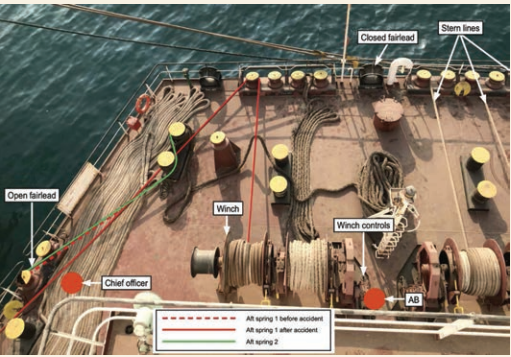202401 - STS mooring fatality
A bulk carrier had arrived at an anchorage to load a cargo of grain from an anchored bulk carrier which was acting as a grain storage vessel.
As edited from MAIB (UK) report 09/2022
https://tinyurl.com/ycy7jcvf
The vessel was moored under pilotage alongside the anchored storage vessel and prepared for the ship-to-ship (STS) transfer of cargo. The mooring arrangement agreed between the Master and pilot consisted of three head lines, three stern lines, two forward springs and two aft springs; all lines belonged to the receiving vessel. Loading commenced using the storage vessel’s crane grabs. At this time the two vessels had similar freeboard.
Some 22 hours later, with loading near 80 percent complete, the forward crane operator on the storage vessel advised his duty officer that the receiving vessel needed to be moved forward to allow the crane grab to reach part of the hold he was loading. By this time, the storage vessel’s deck was about eight metres higher than that of the receiving vessel.

Lesson Learned
- An operation to shift a vessel involved in an STS transfer should be assessed for the development of potential new hazards over the course of the operation – for example, the change in relative vertical reference due to draft changes of each vessel
- During STS transfer operations, mooring lines will develop increasingly vertical leads as the discharging vessel’s freeboard rises and that of the loading vessel falls. To ensure containment of mooring lines that have or develop more vertical leads, closed fairleads should be used.
- be used. l Always evaluate your physical position at a mooring station and stay clear of potential snap-back or other energy release zones.
- Compliance with STCW work/rest requirements does not guarantee a person is not fatigued. Each individual is responsible for ensuring their own sleep hygiene is adequate.
